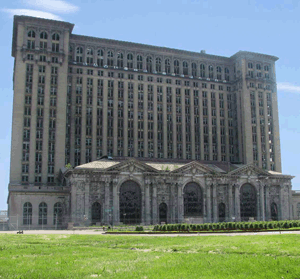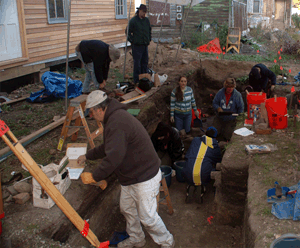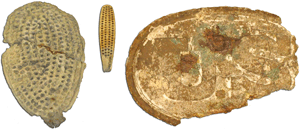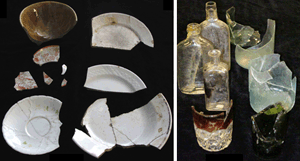
As Detroit paves a new economic road forward, an archaeologist investigates its industrial beginnings

Michigan Central Station, opened in 1913 and eventually decommissioned in 1988, has become a symbol of the decline of Detroit and the disrepair of many of the city's Automotive Age structures.
(Nikhil Swaminathan)
On a Wednesday afternoon in early June, a white bus with the navy blue logo "Indian Trails" emblazoned on its side turns off Michigan Avenue onto 16th Street and heads south. At Dalzelle Street it takes a left and comes to a stop in front of the gutted husk of Michigan Central Station, the former railway hub for Detroit, once the fourth largest city in the United States. A gaggle of tourists hops out of the coach and gawks at the 230-foot-tall building, pointing cameras at it and capturing what has come to be referred to as "ruin porn."
The Beaux-Arts monolith, designed by Reed and Stem, and Warren and Wetmore, the same two architecture firms responsible for New York City's Grand Central Terminal, consists of a three-story depot and an 18-story high-rise. It was rushed into commission the day after Christmas 1913, several months before its planned grand opening, when its downtown predecessor caught fire. In the 1950s, after nearly a half-century as a bustling transportation center, Michigan Central began losing ground to the automobile. By the mid-1980s the station hosted fewer than 10 Amtrak trains per day, and in January 1988 the last train, bound for Chicago, pulled out. Today Michigan Central Station, built when the city was experiencing unprecedented growth, presides over a fallen metropolis that gambled all its resources on a single industry.
Roughly a hundred yards east of the tourists, Tom Killion, an archaeologist who teaches three miles up the road at Wayne State University, is in the fourth week of a six-week survey of the eastern section of Roosevelt Park. This 12-acre patch of land, with its shin-high beds of grass intersected by looping roads, serves as the entry plaza to the abandoned train station and the western border of Corktown, Detroit's oldest extant neighborhood.
Killion is focusing on two sites on either side of one of the city's bestpreserved neighborhoods—a two-story tenement structure on Corktown's east side and, in Roosevelt Park, the remains of more than 100 homes that were demolished to make way for the park. He hopes to uncover artifacts that will tell the story of the early laborers in one of America's hallmark working-class cities. It's the story of Detroit on its upward arc, rather than the oft-told tale that tourists are documenting by photographing the ruin of Michigan Central Station. "We're looking for variation of community structure during the period when Detroit went from being a small frontier military outpost to being, by 1920, one of the foremost industrial centers on the planet," explains Killion.
Officially founded in 1701 by Frenchman Antoine de la Mothe, Sieur de Cadillac, Detroit has taken on a different identity roughly every 100 years. In the century prior to its founding, Detroit slowly morphed from a Native American trading post into a fur trade center, in part due to the presence of Catholic missionaries from France. After Cadillac founded Fort Pontchartrain du Detroit, the fur trade flourished while the French held off advances from British troops, who eventually seized the fort in 1760 during the French and Indian War.
In 1805, a fire consumed the entire settlement. Detroit started over. Redevelopment began with the design of its wheel-and-spoke layout. By 1850 its population was just over 21,000 people, with about half hailing from foreign lands. By 1880, Detroit was the nineteenth largest city in the U.S. with more than 116,000 residents and diverse industrial activity along the riverfront that included metal works, shipbuilding, cigar-rolling, and stove-making.
Its growth continued and, in 1900, the year that saw the birth of the automobile industry, Detroit, by then the nation's thirteenth-biggest city, was best known for making railroad cars. It only took another 20 years for Detroit to become the fourth most populous city in the U.S., with more than 993,000 people. The city would balloon to 1.85 million by the middle of the century, with an economy wholly reliant on the car.
Then a contraction began. "In the nineteenth century, we were very diverse, and then we, in effect, put all our eggs in one basket," says Joel Stone, curator at the Detroit Historical Society. The city once held more than 100 auto companies, but beginning with the closing of the Packard and Hudson Motor Company plants in the 1950s, it hemorrhaged more than 70,000 jobs. The oil crisis of the 1970s then exacerbated what was already a downturn. More recently, the 2008 recession prompted the U.S.'s Big Three automakers—Ford, Chrysler, and General Motors—to approach the government for loans to stay afloat. Detroit's 13.6 percent unemployment rate was the highest of any metropolitan area in the U.S. in February 2009.
Today, with the population down to fewer than 714,000 inhabitants, newspaper, magazine, and television stories about Detroit often describe it as a fallen city. A 2010 BBC documentary on Detroit opened with the line: "Not since the last days of the Maya has the Americas witnessed a transformation as traumatic as that which has befallen the Motor City." Earlier this year, French photographers Yves Marchand and Romain Meffre published a book called Detroit in Ruins that shows many of the city's majestic Automotive Age structures in disrepair, among them Michigan Central Station. (It is one of three books on decaying buildings in Detroit to have come out in the last year.)

Archaeologists, students, and volunteers excavate the backyard of the Workers' Row House.
(Courtesy Anthropology Department/Wayne State University)
On Sixth Street between Labrosse and Porter Streets in Corktown, on a perch above the John C. Lodge Freeway and in the shadow of the Most Holy Trinity Church, is an old, two-story apartment building built in 1849. The home has a brown-and-gray clapboard facade and its front and back are almost identical, with six windows and three faded white doors on each side. Inside are three 560-squarefoot units. In the late 1990s the neighbors called it the "Pioneer House" because, as Tim McKay, former executive director of the Greater Corktown Development Corporation, says, "We didn't know what the hell it was."
Founded in 1834, the neighborhood it sits in got the name Corktown because many of its inhabitants in the mid-1800s had emigrated from the Irish port of Cork. It lies due west of Detroit and is generally well-preserved compared to the city's other older neighborhoods. (One notable exception is Tiger Stadium, built in 1911, which sat near Corktown's center, at the corner of Michigan Avenue and Trumbull Street. It was home to four World Series winners but was demolished in 2009.)
On the neighborhood's eastern edge, south of Michigan Avenue, is an enclave of beautiful Victorian homes, including the Pioneer House. Beginning in the 1850s, it housed immigrant workers who had just arrived by train, found jobs in the industrial center at the riverbanks, and then walked inland to seek places to stay. The first wave of immigrants who settled there was Irish, but the area also became a stronghold for Germans and home to a community hailing from the southern European island of Malta. "Corktown was just far enough out of the city center that it didn't get built over," says Stone. "It was a working-class neighborhood. It was never a fancy neighborhood, and it was close to some of the old industries that we had in town."
In 2002 the pastor of the Most Holy Trinity Church transferred the title on the Pioneer House to the Greater Corktown Development Corporation for one dollar. The Church had been gifted the building, which likely owed its continued existence to its proximity to the house of worship, when its last tenant moved out in 1986. Soon after, McKay and his colleagues began in earnest to investigate the history of the house, eventually persuading Ellen Thackery, a Ball State University graduate student, to study it for her master's thesis in historic preservation.
"The house is a microcosm of Detroit for that period—when the city was this tiny little merchant trading town through the time that it absolutely boomed," explains Thackery, who is now the southeast Michigan field representative for both the Michigan Historic Preservation Network and the National Trust for Historic Preservation. "The house goes from having tenants who are store clerks to, by the 1910s, having all its tenants working in the auto industry." She dove into probate records from the original owners of the house that listed tenants paying rent between 1854 and 1861, city directories that listed renters' names after 1888, and census records. She determined that roughly five people occupied each unit at a time, often a family and a boarder. Her work led to the Pioneer House being renamed the "Workers' Row House."
In her thesis, Thackery suggested that an archaeological assessment of the tenement's backyard might be fruitful. After all, trash collection didn't begin in the area until the late 1880s, so there was likely material that would illustrate the lives of the house's inhabitants. McKay was interested in ultimately developing the Workers' Row House as a small museum and welcomed the opportunity to try to recover some artifacts that could one day be displayed there. So, he placed a call to the anthropology department at Wayne State and was connected with Killion, who was the department chair at the time.
Killion had come to Wayne State in 2001 from the Smithsonian Institution's National Museum of Natural History, where he worked on repatriation claims. His background was in Mesoamerican archaeology, but he had sold the hiring committee at Wayne State on his vision of the department becoming "the archaeological office for the city of Detroit." Assuming an urban archaeologist would take on that task, Killion was focused on running the department and planning his next project in Vera Cruz, Mexico, when McKay called.
When Killion realized the Workers' Row House appeared on a historic map of Detroit that dated to 1853, he jumped at the opportunity. In the fall of 2006, he, students from Wayne State, and volunteers from the community began work on the first excavation in the structure's backyard. The team hoped that the pit they dug would eventually expose the foundation of a structure seen on an 1884 map published by Sanborn, a company that began creating maps for fire insurance purposes in 1866. Killion thought it might be an outhouse or a shed. After 45 days of fieldwork spanning more than two years, the team could see from changes in soil color that the shed had burned down sometime around the turn of the century. Still, they recovered more than 4,000 artifacts from the 1,300-cubic-foot pit.
The finds included silverware, smoking pipes, glass bottles, children's doll parts, darning hooks, a hairbrush, and ceramic dishes. Killion was able to determine that the tenement's inhabitants drank beer brewed 60 miles northeast of Detroit in the town of Port Huron and whiskey brought in from Rochester, New York. On occasion, residents dined on oysters that would have arrived on ice by train from New York or Baltimore. Also found were a Civil War belt buckle, military buttons, and a souvenir from Martin Van Buren's 1840 presidential reelection campaign (he lost to William Henry Harrison).
Given the tenement's location in Corktown and the evidence from Thackery's thesis that tenants typically stayed there for one to three years, likely in order to establish themselves in town, Killion assumed the artifacts would be unified around a theme of "Irishness." He envisioned relics with emblems supporting Irish home rule or ceramics with designs known to be typical in Ireland at the time. Instead, he says, the finds hinted at an upwardly mobile working class. The archaeologists found British pottery produced for mass consumption outside of Great Britain and knockoffs of fine British ceramics made in Ohio.
"Consumer behavior is emerging as the dynamic component of what's happening in this house," Killion explains. "They're buying this stuff because I think they're trying to set a mark a little bit above their station in life. The ladies want nice ceramic wares, not necessarily for everyday use—because we found everyday stuff as well—but maybe to trot out at Thanksgiving or the Fourth of July or for weddings or funerals."
Some of the artifacts are displayed in the Gordon L. Grosscup Museum of Anthropology at Wayne State. The Workers' Row House remains empty. After raising $100,000 over eight years to try to turn it into a museum, the Greater Corktown Development Corporation dissolved in 2010, leaving the tenement in legal limbo (though there's a stipulation that it should be returned to the church). McKay still has ambitions to create a venue for cultural tourism in Corktown and a home for the artifacts, which, he says, have the potential to tell a compelling story by evoking the people who resided there. "It adds depth," he continues. "You become a living museum, a functioning historic site."

A hairbrush, a Civil War belt buckle, and a toothbrush—all
dating to before the 1880s—were among the finds at the
Workers' Row House.
(Courtesy Anthropology Department/Wayne State University)
While the Workers' Row House offered Killion the opportunity to study a single home over time, Roosevelt Park holds the promise of being able to make comparisons among households, to see how diverse an entire neighborhood in Detroit was in the late 1800s and early 1900s. After surveying a few other lots on the east side of Corktown over the past couple of years, Killion turned his attention there this past spring, in part guided by a map created in 1981 by contract archaeologist Stephan Demeter that noted the park as a potentially valuable archaeological site in Corktown.
Before the land was redeveloped to create the park in 1918, it hosted a cluster of clapboard houses that began to appear in the 1860s and 1870s. Killion is looking for the remains of the community that once occupied this plot. To start, he's surveying the park for the remnants of a hotel that stood near the southeast corner of the park more than 90 years ago.
According to Sanborn maps, the hotel existed for between three and seven years—it is nowhere to be found on a 1911 map of the area, but does appear on a 1915 version. It was the only building in the vicinity made of brick, meaning remains of its foundation could probably be located. Graham Sheckels, a master's student in Killion's lab, used geographic information system software to digitally superimpose the contents of the old maps onto the current terrain to aid in the search.
Four weeks of digging in the park hadn't turned up much other than a few bottles, the core of a battery, some ceramics, and an 1864 Indian Head penny. Killion was digging three-foot-deep test pits roughly six-and-a-half feet apart, sifting the earth, and using a meter stick with a camera attached to photograph the stratigraphy. The team dug roughly seven pits per day, but on the Thursday after Memorial Day, when they'd moved north further into the park, they hit the brick building's foundation right where Killion thought it would be. It was, as Sheckels called it, "a validation of my methodology."
With the hotel's foundation located, the team could navigate its way through the park to a line of backyards and privies used by houses that were in lots adjacent to the brick structure. "Each of the lots is an envelope, and in each of the envelopes are the artifacts related to the house," says Killion. "I'm hoping as we go forward to be able to compare these lots as some reflection of the people who were living there for a relatively tight 50-year period of time."
The neighborhood seems to have had some workers' cottages as well as some larger homes. In the lots located just north of the hotel, the Wayne State team uncovered privies and trash pits containing nearly whole pieces of ceramic ware. The initial analysis was that there was some economic variability among the residents of what is now Roosevelt Park. Killion pointed to whole sets of transfer-print plates that indicate that the households were able to afford full sets, rather than picking up a plate here or there, as the tenants of the Workers' Row House might have done.
Less than a week before, Killion felt Roosevelt Park might not be worthy of a full excavation. Today he's giddy about its prospects. "This is an opportunity to look at something that would not otherwise, in most of the rest of Detroit, be available," he says. "It's a time capsule."

The variety of ceramics and glass found in the house lots in Roosevelt Park point to differences in affluence between the households once located there.
(Courtesy Anthropology Department/Wayne State University)
In her book The Irish on the Urban Frontier: Nineteenth Century, 1850-1880, Eastern Michigan University historian JoEllen Vinyard writes, "If there was one quality that characterized Detroit at midpoint in the nineteenth century, it was newness." Today it seems to be less about newness and more about potential. Detroit isn't starting from scratch as it did after the whole city burned down in the 1805 fire. Rather, in planning its revitalization, it has to grapple with ill-advised decisions from its recent past—the highways that sliced through vibrant neighborhoods, the nearly abandoned communities stationed next to still-viable ones, and an automobile-dominated highway system and infrastructure. Several proposals are being floated that focus on aiming resources toward areas where a density of population still exists and abandoning those sections where flight to the suburbs, particularly that of black residents, has left homes and streets barren.
One of those still-viable areas is Corktown. On its west side, urban farmers are descending on the neighborhood's vacant lots, some of which had been most recently used as parking for Tiger Stadium. There are plans by local community activists to develop a skate-friendly plaza in a section of Roosevelt Park (a proposal that could interfere with Killion's plans to do a larger excavation of the area). In 2005, Slows Bar B Q opened across Michigan Avenue from the park, becoming a local hotspot with both the lunch and dinner crowds. A cocktail bar, a coffee shop, and a burger joint will soon open on the same corner, creating what the business owners hope will be a destination spot just outside downtown.
Local realtor Ryan Cooley says that, since moving back to Detroit in 2003 from Chicago, he's seen the neighborhood transformed before his eyes. In fact, in early June, he had no rental inventory available for lease, a testament to the sudden desirability of Corktown. One of the area's big selling points is its history (his slogan is "Modern living in Detroit's oldest neighborhood") and Cooley believes that Killion's work will only enhance the attraction. "When I'm selling the area, people love to find out the history," he says. "If I could tell them, 'This is what was originally built here and here are some of the artifacts that were found,' even if it's just glass bottles, it goes a long way."
Corktown could be considered a bellwether for the future of Detroit. If it's unable to mount a comeback, it may portend an unfortunate fate for the city it abuts. Local business owners note that there are few barriers to entry for those who want to set up shop in Detroit, positioning the city to lure a new generation of immigrants, as it did in the mid-1800s.
Killion agrees that his work has the potential to uncover a rich history that would interest anyone from current and future Corktown residents to new business owners to diners at Slows. He even hopes it can attract a new breed of tourist to replace the hoards of "ruin porn" enthusiasts like the busloads he saw nearly every day at Roosevelt Park. "The place isn't just about this hulking train station ruin," he says. "Detroit needs to tell its own story."
Nikhil Swaminathan is a senior editor at ARCHAEOLOGY.
Advertisement

Advertisement







